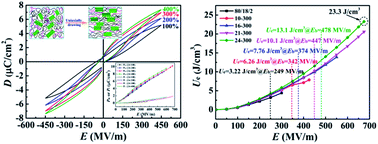High-field antiferroelectric-like behavior in uniaxially stretched poly(vinylidene fluoride-trifluoroethylene-chlorotrifluoroethylene)-grafted-poly(methyl methacrylate) films with high energy density†
Abstract
In an effort to achieve antiferroelectric-like behavior and high Ue under a high electric field, a series of poly(methyl methacrylate) (PMMA) grafted P(VDF-TrFE-CTFE) with increased PMMA content were synthesized via an atom transfer radical polymerization process. All the grafted copolymer films were prepared by a solution-casting process followed by uniaxially stretching with varied extension ratios. The dependence of crystalline, ferroelectric, dielectric and energy storage properties on both the orientation ratio and PMMA content was systematically discussed. Besides the orientation of the polymer chains in the amorphous phase together with the alignment of crystalline and ferroelectric grains, uniaxially drawing the films leads to an improvement in both the content and size of the crystalline and ferroelectric phases. Thanks to the strong confinement of rigid PMMA and the alignment induced high breakdown strength, the antiferroelectric-like behavior could be retained up to 675 MV m−1 with a discharged energy density of 23.3 J cm−3 in the copolymer bearing 24 wt% PMMA with an extension ratio of 300%. These results may help to deeply understand the ferroelectric transition mechanism of PVDF based ferroelectric polymers and provide a promising strategy for the design of polymers with high energy storage capability.


 Please wait while we load your content...
Please wait while we load your content...